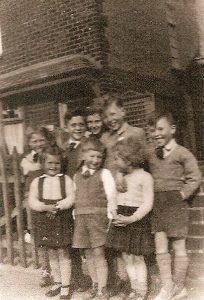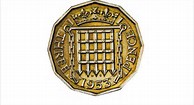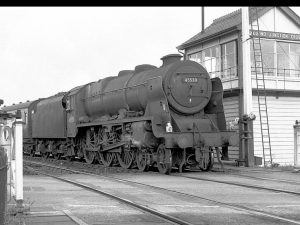Llandudno Junction in the 1950’s
A Talk by David Williams
On October 19th 2017, David Williams gave an entertaining and informative talk to a group of about 50 members and friends of the History of Deganwy Group.
He was born and bred in Llandudno Junction, worked for the Civil Service for many years and has a particular interest in transport. David is vice chair of the Llandudno and Conwy Valley Railway Society – very appropriate for someone coming from a ‘railway family’, as did many others in the area. The railway glory years stretch back some way: in the 1911 census, every house on Queen’s Road had a railwayman living in it!
David was born in 1948, and went to Broad Street School – now Ysgol Maelgwn – where he and other pupils underwent the trials of the nit nurse, milk half-frozen and half-turned from being next to the coal fire, and being expected to sleep on the ‘beds’ taken down from the wall after lunch, amongst other indignities. After being issued with the first pair of NHS glasses in Maelgwn, David was supposed to sit at the front of the class but took to wandering off…leading to the installation of a lock on the school gate, which still exists! However there were some positives – David acquired the gift of reading, and had many happy trips to the small but brilliant library in the Memorial Hall, which was later replaced by a larger version; this is now a café and sadly the Junction no longer has a library.
David showed photographs of where he and the rest of the ‘Penrhos Gang’
– including Haydn Williams, who had the White House in later years, and the twins John and Mair Evans – used to play. Because there were so many nightshift workers (not just railwaymen – also coal and postmen) in the Junction, kids weren’t allowed to play in the street, but plenty of other places were available. These included the playing fields (45-a-side football until it was too dark to see the ball…), Nant y Coed, Bryn Ffynnon, Marl Woods – and of course watching trains from the embankment.
On a Saturday, there were trains coming in to the Junction every few minutes – some Bank Holiday weekends, over 100,000 visitors came to Llandudno by train. Kids in the Junction didn’t need a Hornby trainset – they had the full-size version to play in, in what was known as the Scrapyard, but was actually storage for relief trains needed at busy times.
In the winter, the Brickworks were a good place to keep warm – kids would go in and watch the bricks being made, help load up the wagons and get a lift down into the pit in a truck as a reward.
Mention of by-gone shops and businesses brought back many memories: Harkers Chemist, Haddons Shoe Factory, Chester House, Ted the Barber – one of 5 or 6 barbers in the Junction, and evidence of what a thriving community it was; there were also 5 butchers. Many tradesmen would deliver goods, including bread, vegetables, coal, milk – and fish brought on a handcart from Conwy. Waste food went into a slop bin for the pigs, and everything was recycled: the only thing in the bin would be ashes from the fire.
Other businesses now lost include Hotpoint,
where children would go with their parents for Christmas parties, picking up an apple and an orange from the boxes on the way out, and Crosville, another source of Christmas parties. The currently derelict buildings most recently occupied by Arriva were once home to a row of shops, including Harrisons Newsagents, Hoppers, a bookies, a café and a sweet shop. Castle Cleaners was a dry cleaners based in the large building which is now used by Crest, and opposite it was Vale Laundry – which recently burnt down – where the railwaymen’s overalls were washed.
There were several hotels in the Junction, including the Lancastrian Hotel and Guest House on Marl Drive, and the Maelgwn Hotel.
The most famous is the Station Hotel, known by all still to this day as the Killer, because of the time railwaymen spent between split shifts in it. Many people also took in lodgers or ran B & Bs – including all one side of Penrhos Avenue at one time.
Sources of income for enterprising children included picking mushrooms to sell to Jacksons, newspaper rounds, taking luggage up from the station, ‘recycling’ empty pop bottles from trains and beer bottles from the back of A.J. Lays to try to reclaim the 3d deposit from Taylors.
David once had a stroke of luck caddying at the golf course – he was tipped 30s, which paid for a season ticket at the Lido in Deganwy. There were older lads aged 14 to 15 who had the job of waking up railwaymen at night, if they were late for a shift or were needed unexpectedly. The knockers-up would throw handfuls of cinders from the path up to hit a particular window, whilst trying not to wake the rest of the street up.
Evocative photographs included one of the old level crossing gates on the Junction side of the Cob, with the toll on the other side. Before the new bridge was built in 1958, there would be queues in both directions, with trains passing frequently and a policeman in a white box directing the traffic, often at odds with the signalman.
David also had a great photo of ‘Johnny Onions’, men who cycled all the way from Brittany with bicycles laden with strings of onions (of course!).
To finish, David revealed the contents of the average 7 or 8 year old’s pocket in the 1950s: string for a bow and arrow, conkers, marbles, a homemade catapult, elastic bands and a hanky – to be used for just about everything except blowing your nose.
Members of the audience also contributed their memories, including playing snooker in the Memorial Hall, and catching sticklebacks and newts near what is now Bryn Estyn Badminton Centre. This contributed to a very enjoyable evening, full of human and historical interest.
Lucinda Smith
Latest Research






